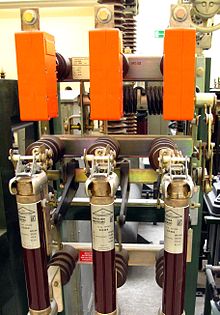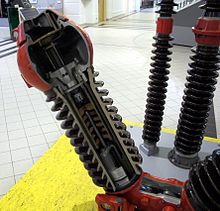High voltage switch
High voltage switches are electrical switches for voltages above 1 kilovolt (kV). Switches for voltages below 1 kV are called low-voltage switches. High-voltage switches are divided into circuit breakers , load switches, switch disconnectors and disconnectors . High-voltage switches are used in substations , load distribution plants or in the area of power plants and are remotely controlled from control centers. They can be equipped with a motor, spring-loaded or compressed air drive. Compact designs can be found in gas-insulated switchgear .

Circuit breaker
The switching capacity, i.e. the possibility of disconnecting an existing electrical connection, is greatest in circuit breakers and is expressed in the form of short-circuit power . Circuit breakers can switch load currents of up to several kiloampere (kA) in the event of a short circuit .
Common selection criteria for circuit breakers are:
- the nominal operating voltage and voltage level
- the nominal operating current (a few kA)
- the short circuit current.
Circuit breakers are generally available for short-circuit currents of 30 kA, 40 kA, 50 kA and 63 kA. It should be noted that every erased short circuit causes a considerably stronger burn on the burn-off tulip and burn-off pin than normal operating currents.
The rated breaking capacity of these switches is in the range of a few 100 MW and up. Due to the large switching capacity, the actual switching process now takes place under protective media such as vacuum or protective gases such as sulfur hexafluoride (SF 6 ). Older circuit breakers with compressed air drives are often designed without shielding gas or a vacuum: the arc that occurs when switching off is blown out by compressed air. In older systems, low-oil circuit breakers are also widespread , in which the arc is extinguished with oil. In the oldest circuit-breaker design, the boiler oil switches that are rarely used today, the switching process takes place in a boiler filled with oil. There is a risk of an oil switch explosion due to the gas formation in the oil from the switching arc .
In the case of circuit breakers, since they always have to be encapsulated in outdoor switchgear, it is not necessarily possible to tell from the outside whether the switch is open or closed.
For higher AC voltages, as in the 400 kV level, two or more power switches are usually connected in series. In the case of the T design, the actual switches are located in the two horizontal ceramic bodies, in the case of the V-shaped arrangement in the two inclined ceramic insulators. In order to divide the alternating voltage evenly between the two switches and to avoid damage caused by excessive voltages on a switch , two high-voltage capacitors are connected in series and act as a capacitive voltage divider . The reactive current occurring when the circuit breaker is open is interrupted by the disconnector connected in series.
Circuit breaker
The circuit breaker is a combination of circuit breaker and disconnector. It can switch operating and no-load currents on and off. The circuit breaker also produces the isolating distance prescribed by DIN / VDE 0105. However, the switch can only be found up to around 40 kV. Circuit breakers are approx. 1/3 cheaper than circuit breakers, but have far fewer switching cycles .
- Example: circuit breaker 22 × 16 kA; Circuit breaker 100 × 16 kA.
Load switch
Load switches switch load or no- load currents in systems up to 30 kV. They are able to switch their rated current "on" and "off". The load switch can also switch "On" up to its rated short-circuit current even in the event of a fault. However, in the event of a fault (short circuit) it cannot switch "Off".
Switch disconnectors

Like the load switch, this high-voltage switch can switch operating currents off and on and switch on short-circuit currents. However, the switch-disconnector also produces the prescribed isolating distance according to DIN / VDE 0105. It is mainly used in the medium voltage range (10 to 30 kV). Its switching capacity is approximately between 40 and 63 kA.
separator
A disconnector has no arc extinguishing device and can therefore only separate electrical circuits from one another when there is no load current flowing. In energy technology, this process is referred to as disconnecting and not switching . In outdoor switchgear, isolators should visibly separate the electrical connection according to VDE 105, the switching capacity can be limited to the capacitive reactive currents of a few 100 mA caused by the line sections.
Disconnectors are usually connected in series with power circuits in the case of line outlets, since an isolator can only be opened or closed when the corresponding circuit breaker is open and thus no significant current flows through the isolator. The actual disconnection process can take up to a few seconds due to the relatively long distances involved in larger disconnectors such as the pantograph disconnector, while the switching process of a circuit breaker takes a few 10 ms.
Earthing switch
The earthing switch creates a conductive and short-circuit-proof connection between the conductor and the earth. A combination of disconnector and earthing switch is often found.
Short-circuiter or quick-release earth
Short circuiters and quick earth electrodes are closed with spring force. Among other things, they are used in switchgear with high-performance high-voltage fuses (HH fuses, i.e., fuses) to prevent an overload e.g. B. can be quickly ended by a distant arc fault that a local short circuit and a grounding are brought about. The short-circuiters are triggered via current transformers and have a spring-loaded storage device that is triggered with a small pull magnet, closes the switch in a very short time and triggers the fuse or a protective device through the short circuit.
Short-circuiters are air-insulated and have a very simple structure, since they only have to switch the short-circuit current on but not off. Short circuiters often have to be opened or tensioned again by hand.
literature
- Réne Flosdorff, Günther Hilgarth: Electrical energy distribution. 4th edition, Verlag BG Teubner, 1982, ISBN 3-519-36411-5
- Wilfried Knies, Klaus Schierack: Electrical systems engineering. 5th edition, Carl Hanser Verlag, Munich and Vienna, 2006, ISBN 3-446-40574-7
- Günter Springer: Expertise in electrical engineering. 18th edition, Verlag Europa-Lehrmittel, Wuppertal, 1989, ISBN 3-8085-3018-9



